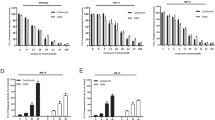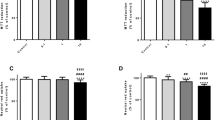Abstract
With the development and approval of new proteasome inhibitors, proteasome inhibition is increasingly recognized in cancer therapy. Besides successful anti-cancer effects in hematological cancers, side effects such as cardiotoxicity are limiting effective treatment. In this study, we used a cardiomyocyte model to investigate the molecular cardiotoxic mechanisms of carfilzomib (CFZ) and ixazomib (IXZ) alone or in combination with the immunomodulatory drug dexamethasone (DEX) which is frequently used in combination therapies in the clinic. According to our findings, CFZ showed a higher cytotoxic effect at lower concentrations than IXZ. DEX combination attenuated the cytotoxicity for both proteasome inhibitors. All drug treatments caused a marked increase in K48 ubiquitination. Both CFZ and IXZ caused an upregulation in cellular and endoplasmic reticulum stress protein (HSP90, HSP70, GRP94, and GRP78) levels and DEX combination attenuated the increased stress protein levels. Importantly, IXZ and IXZ-DEX treatments caused upregulation of mitochondria fission and fusion gene expression levels higher than caused by CFZ and CFZ-DEX combination. The IXZ-DEX combination reduced the levels of OXPHOS proteins (Complex II–V) more than the CFZ-DEX combination. Reduced mitochondrial membrane potential and ATP production were detected with all drug treatments in cardiomyocytes. Our findings suggest that the cardiotoxic effect of proteasome inhibitors may be due to their class effect and stress response and mitochondrial dysfunction may be involved in the cardiotoxicity process.





Similar content being viewed by others
References
Wu, P., Oren, O., Gertz, M. A., & Yang, E. H. (2020). Proteasome inhibitor-related cardiotoxicity: Mechanisms, diagnosis, and management. Current Oncology Reports, 22(7), 1–14.
Shah, C., Bishnoi, R., Jain, A., Bejjanki, H., Xiong, S., Wang, Y., Zou, F., & Moreb, J. S. (2018). Cardiotoxicity associated with carfilzomib: Systematic review and meta-analysis. Leukemia & lymphoma, 59(11), 2557–2569.
Jouni, H., Aubry, M. C., Lacy, M. Q., Kumar, S. K., Frye, R. L., & Herrmann, J. (2017). Ixazomib cardiotoxicity: A possible class effect of proteasome inhibitors. American Journal of Hematology, 92(2), 220–221.
Shirley, M. (2016). Ixazomib: First global approval. Drugs, 76(3), 405–411.
Ling, Y., Li, R., Zhong, J., Zhao, Y., & Chen, Z. (2022). Ixazomib-associated cardiovascular adverse events in multiple myeloma: A systematic review and meta-analysis. Drug and Chemical Toxicology, 45(4), 1443–1448.
Latif, A., Kapoor, V., Lateef, N., Ahsan, M. J., Usman, R. M., Malik, S. U., Ahmad, N., Rosko, N., Rudoni, J., William, P., Khouri, J., & Anwer, F. (2021). Incidence and management of carfilzomib-induced cardiovascular toxicity; A systematic review and meta-analysis. Cardiovascular & Haematological Disorders-Drug Targets (Formerly Current Drug Targets-Cardiovascular & Hematological Disorders), 21(1), 30–45.
Dispenzieri, A., Kastritis, E., Wechalekar, A. D., Schönland, S. O., Kim, K., Sanchorawala, V., Landau, H. J., Kwok, F., Suzuki, K., Comenzo, R. L., Berg, D., Liu, G., Kumar, A., Faller, D. V., & Merlini, G. (2022). A randomized phase 3 study of ixazomib–dexamethasone versus physician’s choice in relapsed or refractory AL amyloidosis. Leukemia, 36(1), 225–235.
Das, A., Dasgupta, S., Gong, Y., Shah, U. A., Fradley, M. G., Cheng, R. K., Roy, B., & Guha, A. (2022). Cardiotoxicity as an adverse effect of immunomodulatory drugs and proteasome inhibitors in multiple myeloma: A network meta-analysis of randomized clinical trials. Hematological Oncology, 40(2), 233–242.
Varga, Z. V., Ferdinandy, P., Liaudet, L., & Pacher, P. (2015). Drug-induced mitochondrial dysfunction and cardiotoxicity. American Journal of Physiology-Heart and Circulatory Physiology, 309(9), H1453–H1467.
Gilda, J. E., & Gomes, A. V. (2017). Proteasome dysfunction in cardiomyopathies. The Journal of Physiology, 595(12), 4051–4071.
Patel, M. B., & Majetschak, M. (2007). Distribution and interrelationship of ubiquitin proteasome pathway component activities and ubiquitin pools in various porcine tissues. Physiological Research, 56(3), 341–350.
Livak, K. J., & Schmittgen, T. D. (2001). Analysis of relative gene expression data using real-time quantitative PCR and the 2− ΔΔCT method. Methods, 25(4), 402–408.
Wang, J., Fang, Y., Fan, R. A., & Kirk, C. J. (2021). Proteasome inhibitors and their pharmacokinetics, pharmacodynamics, and metabolism. International Journal of Molecular Sciences, 22(21), 11595.
Cole, D. C., & Frishman, W. H. (2018). Cardiovascular complications of proteasome inhibitors used in multiple myeloma. Cardiology in Review, 26(3), 122–129.
Grandin, E. W., Ky, B., Cornell, R. F., Carver, J., & Lenihan, D. J. (2015). Patterns of cardiac toxicity associated with irreversible proteasome inhibition in the treatment of multiple myeloma. Journal of Cardiac Failure, 21(2), 138–144.
de Bruin, G., Xin, B. T., Kraus, M., van der Stelt, M., van der Marel, G. A., Kisselev, A. F., Driessen, C., Florea, B. I., & Overkleeft, H. S. (2016). A set of activity-based probes to visualize human (Immuno)proteasome activities. Angewandte Chemie International Edition, 55(13), 4199–4203. https://doi.org/10.1002/anie.201509092
Demo, S. D., Kirk, C. J., Aujay, M. A., Buchholz, T. J., Dajee, M., Ho, M. N., Jiang, J., Laidig, G. J., Lewis, E. R., Parlati, F., Shenk, K. D., Smyth, M. S., Sun, C. M., Vallone, M. K., Woo, T. M., Molineaux, C. J., & Bennett, M. K. (2007). Antitumor activity of PR-171, a novel irreversible inhibitor of the proteasome. Cancer Research, 67(13), 6383–6391. https://doi.org/10.1158/0008-5472.CAN-06-4086
Kupperman, E., Lee, E. C., Cao, Y., Bannerman, B., Fitzgerald, M., Berger, A., Yu, J., Yang, Y., Hales, P., Bruzzese, F., Liu, J., Blank, J., Garcia, K., Tsu, C., Dick, L., Fleming, P., Yu, L., Manfredi, M., Rolfe, M., & Bolen, J. (2010). Evaluation of the proteasome inhibitor MLN9708 in preclinical models of human cancer. Cancer Research, 70(5), 1970–1980.
Mendez-Lopez, M. A., Besse, A., Florea, B., Zuppinger, C., Overkleeft, H., Driessen, C., & Besse, L. (2019). Carfilzomib induces cardiotoxicity via ß5/ß2-specific proteasome subunit inhibition pattern. Blood, 134, 3110.
Besse, A., Besse, L., Kraus, M., Mendez-Lopez, M., Bader, J., Xin, B. T., de Bruin, G., Maurits, E., Overkleeft, H. S., & Driessen, C. (2019). Proteasome inhibition in multiple myeloma: Head-to-head comparison of currently available proteasome inhibitors. Cell Chemical Biology, 26(3), 340–351.
Mateos, M. V., Goldschmidt, H., San-Miguel, J., Mikhael, J., DeCosta, L., Zhou, L., Obreja, M., Blaedel, J., Szabo, Z., & Leleu, X. (2018). Carfilzomib in relapsed or refractory multiple myeloma patients with early or late relapse following prior therapy: A subgroup analysis of the randomized phase 3 ASPIRE and ENDEAVOR trials. Hematological Oncology, 36(2), 463–470.
Fradley, M. G., Groarke, J. D., Laubach, J., Alsina, M., Lenihan, D. J., Cornell, R. F., Maglio, M., Shain, K. H., Richardson, P. G., & Moslehi, J. (2018). Recurrent cardiotoxicity potentiated by the interaction of proteasome inhibitor and immunomodulatory therapy for the treatment of multiple myeloma. British Journal of Haematology, 180(2), 271–275.
Moreau, P., Masszi, T., Grzasko, N., Bahlis, N. J., Hansson, M., Pour, L., Sandhu, I., Ganly, P., Baker, B. W., Jackson, S. R., Stoppa, A. M., Simpson, D. R., Gimsing, P., Palumbo, A., Garderet, L., Cavo, M., Kumar, S., Touzeau, C., Buadi, F. K., … TOURMALINE-MM1 Study Group. (2016). Oral ixazomib, lenalidomide, and dexamethasone for multiple myeloma. New England Journal of Medicine, 374(17), 1621–1634.
Hasinoff, B. B., & Patel, D. (2018). Myocyte-damaging effects and binding kinetics of boronic acid and epoxyketone proteasomal-targeted drugs. Cardiovascular Toxicology. https://doi.org/10.1007/s12012-018-9468-9
Meyer, J. N., Leuthner, T. C., & Luz, A. L. (2017). Mitochondrial fusion, fission, and mitochondrial toxicity. Toxicology, 391, 42–53.
Nan, J., Zhu, W., Rahman, M. S., Liu, M., Li, D., Su, S., Zhang, N., Hu, X., Yu, H., Gupta, M. P., & Wang, J. (2017). Molecular regulation of mitochondrial dynamics in cardiac disease. Biochimica et Biophysica Acta (BBA)-Molecular Cell Research, 1864(7), 1260–1273.
Olmedo, I., Pino, G., Riquelme, J. A., Aranguiz, P., Díaz, M. C., López-Crisosto, C., Lavandero, S., Donoso, P., Pedrozo, Z., & Sánchez, G. (2020). Inhibition of the proteasome preserves Mitofusin-2 and mitochondrial integrity, protecting cardiomyocytes during ischemia-reperfusion injury. Biochimica et Biophysica Acta (BBA)-Molecular Basis of Disease, 1866(5), 165659.
Chen, I. C., Liu, Y. C., Wu, Y. H., Lo, S. H., Wang, S. C., Li, C. Y., Dai, Z. K., Hsu, J. H., Yeh, C. Y., & Tseng, Y. H. (2022). Proteasome inhibitors decrease the viability of pulmonary arterial smooth muscle cells by restoring mitofusin-2 expression under hypoxic conditions. Biomedicines, 10(4), 873.
Tibullo, D., Giallongo, C., Romano, A., Vicario, N., Barbato, A., Puglisi, F., Parenti, R., Amorini, A. M., Wissam Saab, M., Tavazzi, B., Mangione, R., Brundo, M. V., Lazzarino, G., Palumbo, G. A., Volti, G. L., Raimondo, F. D., & Lazzarino, G. (2020). Mitochondrial functions, energy metabolism and protein glycosylation are interconnected processes mediating resistance to bortezomib in multiple myeloma cells. Biomolecules, 10(5), 696.
Kolwicz, S. C., Jr., Purohit, S., & Tian, R. (2013). Cardiac metabolism and its interactions with contraction, growth, and survival of cardiomyocytes. Circulation Research, 113(5), 603–616.
Hoppins, S. (2014). The regulation of mitochondrial dynamics. Current Opinion in Cell Biology, 29, 46–52.
Chen, H., Vermulst, M., Wang, Y. E., Chomyn, A., Prolla, T. A., McCaffery, J. M., & Chan, D. C. (2010). Mitochondrial fusion is required for mtDNA stability in skeletal muscle and tolerance of mtDNA mutations. Cell, 141(2), 280–289.
Forghani, P., Rashid, A., Sun, F., Liu, R., Li, D., Lee, M. R., Hwang, H., Maxwell, J. T., Mandawat, A., Wu, R., Salaita, K., & Xu, C. (2021). Carfilzomib treatment causes molecular and functional alterations of human induced pluripotent stem cell-derived cardiomyocytes. Journal of the American Heart Association, 10(24), e022247.
Stahn, C., & Buttgereit, F. (2008). Genomic and nongenomic effects of glucocorticoids. Nature Clinical Practice Rheumatology, 4(10), 525–533.
Desquiret, V., Gueguen, N., Malthièry, Y., Ritz, P., & Simard, G. (2008). Mitochondrial effects of dexamethasone imply both membrane and cytosolic-initiated pathways in HepG2 cells. The International Journal of Biochemistry & Cell Biology, 40(8), 1629–1641.
Troncoso, R., Paredes, F., Parra, V., Gatica, D., Vásquez-Trincado, C., Quiroga, C., Bravo-Sagua, R., López-Crisosto, C., Rodriguez, A. E., Oyarzún, A. P., Kroemer, G., & Lavandero, S. (2014). Dexamethasone-induced autophagy mediates muscle atrophy through mitochondrial clearance. Cell Cycle, 13(14), 2281–2295.
Zhou, R., Li, J., Zhang, L., Cheng, Y., Yan, J., Sun, Y., Wang, J., & Jiang, H. (2020). Role of Parkin-mediated mitophagy in glucocorticoid-induced cardiomyocyte maturation. Life Sciences, 255, 117817.
Rajashree, S., & Puvanakrishnan, R. (1998). Dexamethasone induced alterations in enzymatic and nonenzymatic antioxidant status in heart and kidney of rats. Molecular and Cellular Biochemistry, 181(1), 77–85.
Karademir, B., Sari, G., Jannuzzi, A. T., Musunuri, S., Wicher, G., Grune, T., Mi, J., Hacioglu-Bay, H., Forsberg-Nilsson, K., Bergquist, J., & Jung, T. (2018). Proteomic approach for understanding milder neurotoxicity of Carfilzomib against Bortezomib. Scientific Reports, 8(1), 16318.
Jannuzzi, A. T., Arslan, S., Yilmaz, A. M., Sari, G., Beklen, H., Méndez, L., Fedorova, M., Arga, K. Y., Karademir Yilmaz, B., & Alpertunga, B. (2020). Higher proteotoxic stress rather than mitochondrial damage is involved in higher neurotoxicity of bortezomib compared to carfilzomib. Redox Biology, 32, 101502.
Funding
This study is supported by Istanbul University Research Fund. (Grant No: TSA-2019–33638).
Author information
Authors and Affiliations
Contributions
ATJ, BKY, and BA designed the experiments. ATJ, NSK, AGA, and SAE performed the experiments and analyzed the data. ATJ wrote the manuscript. All of the authors reviewed and edited the manuscript.
Corresponding author
Ethics declarations
Competing interest
The authors declare that they have no known competing financial interests or personal relationships that could have appeared to influence the work reported in this paper.
Additional information
Handling Editor: Kumuda Das.
Publisher's Note
Springer Nature remains neutral with regard to jurisdictional claims in published maps and institutional affiliations.
Supplementary Information
Below is the link to the electronic supplementary material.
Rights and permissions
Springer Nature or its licensor (e.g. a society or other partner) holds exclusive rights to this article under a publishing agreement with the author(s) or other rightsholder(s); author self-archiving of the accepted manuscript version of this article is solely governed by the terms of such publishing agreement and applicable law.
About this article
Cite this article
Jannuzzi, A.T., Korkmaz, N.S., Gunaydin Akyildiz, A. et al. Molecular Cardiotoxic Effects of Proteasome Inhibitors Carfilzomib and Ixazomib and Their Combination with Dexamethasone Involve Mitochondrial Dysregulation. Cardiovasc Toxicol 23, 121–131 (2023). https://doi.org/10.1007/s12012-023-09785-7
Received:
Accepted:
Published:
Issue Date:
DOI: https://doi.org/10.1007/s12012-023-09785-7




